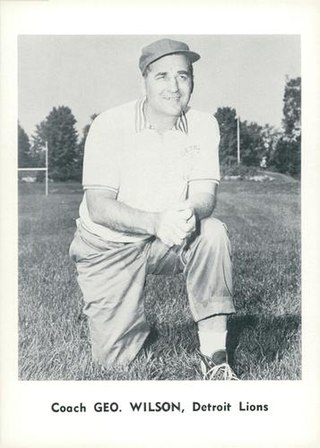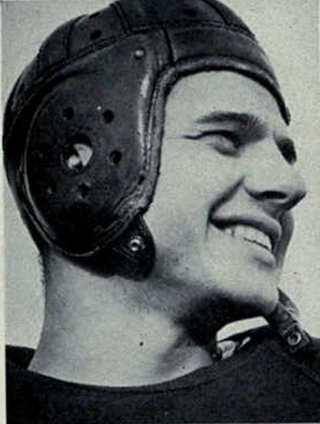Related Research Articles
The American Basketball League (ABL) was an early professional basketball league. During six seasons from 1925–26 to 1930–31, the ABL was the first attempt to create a major professional basketball league in the United States.
The Sheboygan Red Skins were a professional basketball team based in Sheboygan, Wisconsin, which was an original National Basketball Association franchise during the 1949–50 season.

Alphonse Emil "Tuffy" Leemans was an American professional football player who was a fullback and halfback who played on both offense and defense for the New York Giants of the National Football League (NFL). He was inducted into the Pro Football Hall of Fame in 1978 and was named in 1969 to the NFL 1930s All-Decade Team.

George William Wilson, Sr. was a professional football end and later a coach for the National Football League (NFL)'s Detroit Lions and the American Football League (AFL)'s Miami Dolphins. Wilson attended and played football at Northwestern University. He went undrafted in 1937, before being signed by the Chicago Bears. Wilson played for ten seasons with the Bears, compiling overall record of 111 pass receptions, 1,342 receiving yards, and fifteen touchdowns. He was a member of the Bears during their five appearances in the National Football League Championship Game from 1940–1943 and 1946. Additionally, he was selected for the NFL All-Star Game from 1940–1942. He also played one season of professional basketball for the Chicago Bruins in 1939–40. Wilson won seven championships combined as a player and coach.
Barney Sedran was an American professional basketball player in the 1910s and 1920s who is in the Basketball Hall of Fame.

Raymond Paul Flaherty was an American professional football player and coach in the National Football League (NFL). He was part of three NFL championship teams, one as a player and two as a head coach. He was inducted into the Pro Football Hall of Fame as a coach.
James Vincent "Jim" Castiglia was an American football fullback in the National Football League (NFL) for the Washington Redskins and Philadelphia Eagles as well as the Baltimore Colts of the All-America Football Conference (AAFC). He also briefly played Major League Baseball as a catcher for the Philadelphia Athletics.
The World Professional Basketball Tournament was an annual invitational tournament held in Chicago from 1939 to 1948 and sponsored by the Chicago Herald American. Many teams came from the National Basketball League, but it also included the best teams from other leagues and the best independent barnstorming teams such as the New York Rens and Harlem Globetrotters. Games were played at various sites including Chicago Coliseum, International Amphitheater and Chicago Stadium.

Douglas Pershing Turley was an American professional football player and coach and basketball player. He played end for five seasons for the Washington Redskins of the National Football League (NFL), two with the Wilmington Clippers and one with the Bethlehem Bulldogs of the American Association (AA), and additionally had stints in the NFL with the Pittsburgh Steelers and Philadelphia Eagles. Turley also served as the Clippers' head coach for part of the 1949 season and played basketball with the Wilmington Blue Bombers of the American Basketball League (ABL), in addition to with several semi-professional teams. A resident of Delaware for most of his life, he was inducted into the Delaware Sports Hall of Fame in 1986.
Clyde Earl Shugart was an American football guard in the National Football League (NFL) for the Washington Redskins. He played college football at Iowa State University and was drafted in the seventeenth round of the 1939 NFL Draft.

Leroy Harry Edwards, nicknamed "Cowboy" and "Lefty", was one of the greatest basketball players of his era. He was an NCAA All-American at the University of Kentucky and also one of the most lauded professional players in the United States' National Basketball League's history.

Edward C. Frutig was an American football end who played for the University of Michigan Wolverines from 1938 to 1940. He was selected as a first-team All-American in 1940 by William Randolph Hearst's International News Service. A teammate of Heisman Trophy winner Tom Harmon for three years at Michigan, Frutig was Harmon's main receiver, and played in the National Football League (NFL) with the Green Bay Packers and Detroit Lions (1945–1946).

James Carlos McNatt was an All-American basketball player for the Oklahoma Sooners and the AAU's Phillips 66ers. At Oklahoma, McNatt led his team to the first-ever NCAA final Four in 1939, and at Phillips 66, McNatt guided the 66ers to four consecutive AAU national championships. He was a two-time All-American at Oklahoma and a four-time AAU All-American for Phillips 66. The speedy player came to be known by his nickname “Scat” McNatt, a moniker originally traced back to the term “Boy Scats” which sportswriters had used to describe McNatt's fast-breaking, sophomore-led 1937-38 Oklahoma Sooners basketball team. McNatt grew up in Norman, Oklahoma, attended Norman High School, and then opted to stay in his hometown to play basketball for the University of Oklahoma.
Robert Horace "Doc" Erskine was an American college football and basketball coach. He served at Loyola University New Orleans as the head football coach from 1933 to 1934 and as the head basketball coach from 1924 to 1925 and 1933 to 1939.

The History of Michigan Wolverines football in the Crisler years covers the history of the University of Michigan Wolverines football program during the period from the hiring of Fritz Crisler as head coach in 1938 through his retirement as head coach after winning the 1948 Rose Bowl. Michigan was a member of the Big Ten Conference during the Crisler years and played its home games at Michigan Stadium.

Francis E. Zummach was an American basketball player and coach. He served as the head coach of the Sheboygan Red Skins, a team that played in the National Basketball League (NBL) and later the National Basketball Association (NBA), from 1939 to 1942. In 1940–41, the Red Skins made it to the NBL Finals before losing the series 3 games to 0 to the Oshkosh All-Stars. Zummach lived to become a centenarian and died when he was 101 years old.

Melvin Clay Brewer was an American football player and coach. He played college football at the University of Illinois where he was selected as a second-team All-American in 1939.

John William Drish was an American basketball and baseball player.
The 1940 NCAA Basketball Championship Game was the final of the 1940 NCAA basketball tournament and determined the national champion in the 1939–40 NCAA men's basketball season. The game was held at the Municipal Auditorium in Kansas City, Missouri, on March 30, 1940. The Indiana Hoosiers defeated the Kansas Jayhawks 60–42 to win the school's first national championship in men's basketball.
The 1940 World Professional Basketball Tournament was the second edition of the World Professional Basketball Tournament. It was held in Chicago, Illinois, during the days of 18–22 March 1940 and featured 13 teams. It was won by the Harlem Globetrotters who defeated the Chicago Bruins 31–29 in the title game. The Washington Heurich Brewers came in third after beating the Syracuse Reds 41–30 in the third-place game. Sonny Boswell of the Harlem Globetrotters was named the tournament's Most Valuable Player.
References
- 1 2 "Washington Heurichs Franchise History (1938-1941)". Stats Crew. Retrieved Apr 17, 2024.
- ↑ "Washington Brewers: 1938-1939". Pro Basketball Encyclopedia. Retrieved Apr 17, 2024.
- ↑ "Washington Brewers.: 1939-1940". Pro Basketball Encyclopedia. Retrieved Apr 17, 2024.
- ↑ "Washington Brewers: 1940-1941". Pro Basketball Encyclopedia. Retrieved Apr 17, 2024.
- ↑ "Washington Brewers: 1941-1942". Pro Basketball Encyclopedia. Retrieved Apr 17, 2024.
- 1 2 "Washington Brewers: History 1939-1942 (4 seasons)". RetroSeasons. Retrieved Apr 17, 2024.